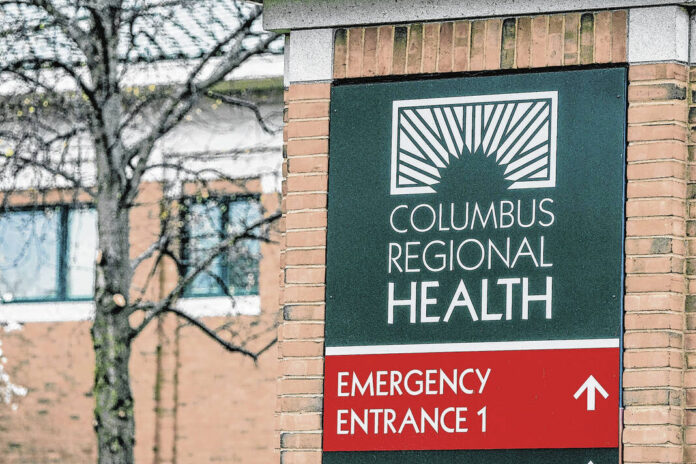
Republic file photo An exterior view of Columbus Regional Hospital’s sign directing patients to the emergency entrance.
COVID-19 hospitalizations at Columbus Regional Hospital have climbed to their highest level in more than five months as Bartholomew County records its first death from the virus in weeks.
There were 18 people hospitalized with COVID-19 at CRH on Wednesday, up from 11 two weeks ago and the highest daily total since Feb. 22, according to the most recent data from the local coronavirus task force.
The figures include people who are hospitalized due to COVID-19 infections and people who test positive for the virus but are hospitalized for other reasons, the hospital said.
“The majority of hospitalizations are because of COVID illness,” said CRH spokeswoman Kelsey DeClue. “But we also do have the factor of because of such high community spread, we have a few patients that are in the hospital with COVID but not because of it.”
The “overwhelming majority” of people who are hospitalized at CRH due to coronavirus infections never got vaccinated or didn’t keep up with their booster shots, DeClue said.
Currently, people ages 18 and up who received the Pfizer-BioNTech or Moderna vaccines are eligible for a booster shot five months after they complete their initial series, according to the Centers for Disease Control and Prevention.
Those who got the single-shot Johnson & Johnson vaccine are eligible two months after their initial shot. People with compromised immune systems are generally eligible for boosters as soon as three months after their primary series.
Children ages 5 to 17 who got the Pfizer vaccine are eligible for boosters five months after their initial series.
Adults ages 50 and up are eligible for a second booster shot at least four months after their first booster.
“If you have not gotten that booster yet and you are eligible for it … absolutely go and get that because we are seeing the effects of that either not up to date or have not been vaccinated as the overwhelming majority of hospital cases, especially in those older populations as well,” DeClue said.
The update from the hospital comes about a week after Bartholomew County recorded its first COVID-19 death in 40 days, according to the Indiana Department of Health.
On July 30, Bartholomew County recorded its 245th death from the virus over the course of the pandemic. In addition, one virus death has been recorded in both Jackson and Jennings counties over the past month.
In addition, the CDC has maintained Bartholomew County’s COVID-19 risk level in the orange category, which is the highest category of community spread, recommending that all local residents wear a mask indoors while in public, including in K-12 schools and on public transit — regardless of vaccination status.
Currently, it is hard to say exactly how prevalent COVID-19 is in Bartholomew County, as many people are testing with at-home kits and not reporting the results to health officials.
However, the concentration of COVID-19 in Bartholomew County’s wastewater continues to rise it its highest level since the peak of the omicron surge this past winter, according to the CDC’s wastewater surveillance program.
During a two-week period ending July 31, the concentration of COVID-19 in local sewage was 79% of what it was during the height of the pandemic this past winter, up from 42% a month ago.
Many public health experts have said that sewage testing may paint a more accurate picture of viral spread than testing. People infected with the coronavirus that causes COVID-19 can shed genetic material from the virus in their feces, and this material can be detected in community wastewater, according to the CDC.
DeClue said the hospital system is seeing many less severe cases of COVID-19, with people age 70 and up tending to be at the highest risk for severe illness. However, there still are severe cases, as three people were in CRH’s intensive care unit Friday morning battling coronavirus infections.
“This slow climb (in COVID-19 hospitalizations) and the rate at which it has stayed is concerning, and it feels a bit longer than some of the past spikes,” DeClue said. “…This latest spike, or continued spike, comes right at back-to-school time. Looking at outside factors that could keep a spike going, that’s certainly one of them that is concerning.”




